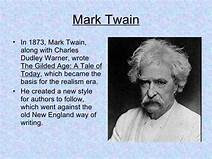 |
| Imitation of Mark Twain's style of writing |
His name was Samuel Langhorn Clemens, but we know him as the American writer Mark Twain, he is famous not only for his humor but also for his funny conversational style based on American cad. Mark Twain copied in the vernacular the way people thought about writing Changed in the second chapter of Tom Sawyer, young Tom speaks in a language unsaturated in that culture when he tried to persuade another boy to draw a fence for him:
"It needs to be done very carefully; I don't think there's a single boy out of a thousand, maybe two thousand, who can do it the way it was possible." (Twain)
This is the most sophisticated work of any writer, written in spoken language.
If writers want to imitate Mark Twain's style of writing, they must first determine whether they want to portray characters from Twain's Mississippi River region or any other English-speaking region. The key is to capture how people accidentally speak. Twain's extraordinary style of writing was different from that of other writers of his day because he chose to write the way the people of his region spoke. But residents of the United Kingdom appreciated his style and invited him to entertain him there.
Capturing natural speech while making it enjoyable is not an easy task. Most readers are surprised to discover that the way people speak is the only form of writing that is more difficult than academic writing. To do this, one must answer the two basic questions described in this article. He or she can then apply four strategies to achieve the goal of using behavior effectively in fiction books.
Read about Health & Fitness news in English: Click Here :
First, one should ask oneself where the heroes of his novel live and where they were born.While its characters may not be based on real people, they must have a personal background known as history. If the author wants to illustrate the natural way they speak, personal history is essential. If one wants his characters to sound like Mark Twain's characters, they can come from the Midwestern state of Missouri or live along the Missouri River, which flows along the Missouri border (however, the Mississippi River flows through the entire ten states). If the storyteller is not very familiar with how people speak in that area, there may be better writing about a dialect or pronunciation that he knows well. Choosing a character from other English-speaking parts of the world would work just as well and would be completely original. For example, someone might choose a character from Australia, where people are known for telling outstanding jokes that delight readers or someone might put his characters in New York City.
Second, writers should ask themselves about the educational background of their heroes.
There are many unconventional ways to learn life - in addition to the brick-and-mortar school. Perhaps someone’s characters have learned through the streets, the internet, or other real-life experiences. Living in a particular neighborhood, being part of a unique family in the theater profession, or being the daughter of a well-known truck driver are all experiences that influence the way her characters think and express themselves. The characters face challenges like homelessness, getting a second chance in life or falling in love. Such unique, unconventional characters deeply enlighten the reader that enlightens them. Dishonest characters are portrayed as foolish as well as not behaving. In addition, numerous characters slur their words or use compression, usually in spoken English.
Once the author has answered these two essential questions (previously mentioned) about the background of the characters, he or she can follow four necessary steps:
Step 1 Writers should first get acquainted with the vocabulary and jargon of the period in which the characters in their story survive. Typically, the most successful stories emerge when people write about what they observe around them.
While perfect writing about the distant past can be accomplished, writing about medieval England is not easy when you only have the experience of modern life in Ohio or California. If one likes to write about a period from a distant past, one needs to do some research and, if possible, read a few books from that period. An American character in 1950 could use the word "swollen" to describe something he wanted, whereas in 2020 the same character is usually called "great."
The following are some of the terms commonly used in the 1940s: Dame (a woman); A geyser (an elderly person); An enthusiastic-beaver (an enthusiastic person); And sticky (cheap).
Here are some of the words that were popular in Mark Twain's time: to bring (to get something and bring it back); to reckon (to be opinion); ornery (difficult to deal with); Seeds (incomplete); And there (there).
Step 2 It is advisable to read some books or watch some movies set within the time period you want to write a movie. Make notes with vocabulary that anyone can use in someone’s story. If the author encounters some words that the story does not seem to occur with the same period, he can do some research on the etymology of the words when they were first used. Listen to the latest terminology used on TV and consider how the language develops. For example, many new expressions such as "social distance" and "super-spreader" came into use after the COVID-19 crisis.
Step 3 Consider the linguistic article of the characters in someone’s story. Do they use a formal or informal tone? When using formal tones in some situations they probably speak in an informal tone most of the time. The chronological age of the characters also affects their verbal expressions and methods. An older adult may use some expressions that are different from those of a teenager. A member of a street gang communicates differently than a university student. The characters create an interesting contrast with the various linguistic articles that face each other.
Step 4 Read some of Mark Twain's fictional books for inspiration. It is said that writers should read many books by the author that they want to imitate. One can learn a lot just by observing a writer's style, and this knowledge of rhythm and melody can be applied to one's writing depending on the 1800s or other periods. It can inspire science fiction writing where writers create new words used in an imaginary future environment.
As Aunt Polly jokingly says in the fourth chapter of Tom Sawyer:
"Oh, Tom, you're a thick-headed thing, I'm not bothering you. I won't do it. You must learn again. Tom, you will not be disappointed. Tom, you will handle it. I'll give you something nice. Now, this is a good boy. "(Twain)
Polly's language is not academic jargon. Instead, it gives Polly an example of a natural rhythm based on everyday speech as she asks Tom to learn. His speech is like that of an elder talking to children even today. The main element of a fictional conversation must be, it is an interesting and fun conversation with a pleasing rhythm and melody no matter what the image of the period shows.
The Best Free Image website: https://freeimage4k.blogspot.com/
The Best English Grammar Learning Website: https://msrnenglish.blogspot.com/





0 Comments